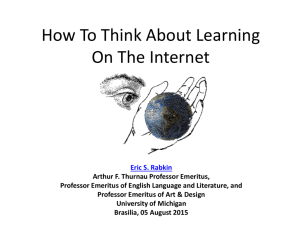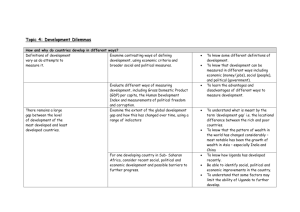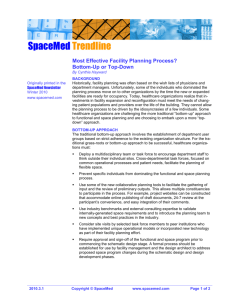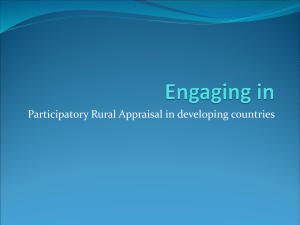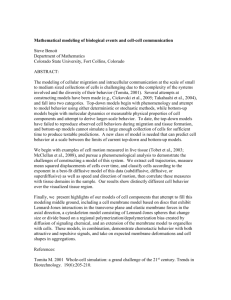Project Identification: Approaches & Methods
advertisement
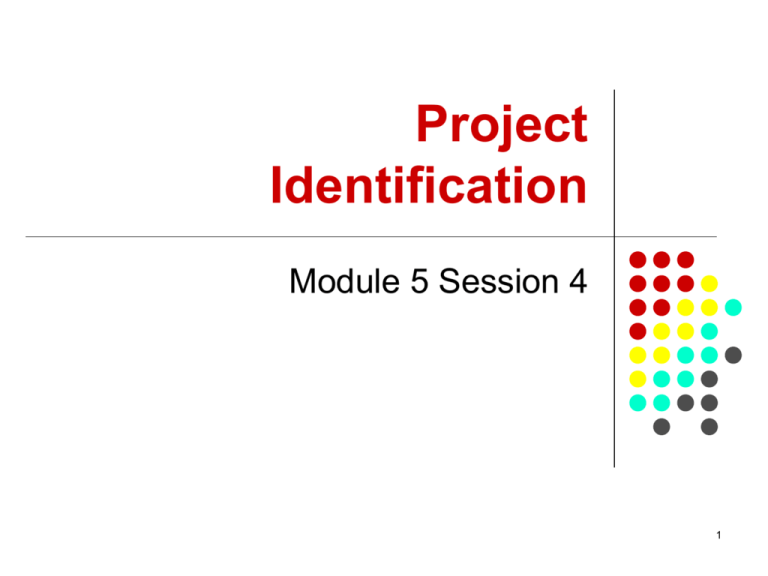
Project Identification Module 5 Session 4 1 Summary This session gives introduction and approaches to project identification. It looks at: the context within which projects are developed including national and sectoral plans e.g. UPE, District development plans, NGOs, and Donor initiatives. the types of surveys and data available for project identification purposes. It also looks at identification and prioritization of needs and problems of different stakeholders. 2 Introduction A project may be seen as an investment activity where financial resources are expended to create capital assets that produce benefits over extended period of time. Project identification is the initial phase of the project development cycle. It begins with the conceiving of ideas or intentions to set up a project. These ideas are then transformed into a project. 3 Essential characteristics of projects For projects to be properly conceived, the characteristics below must be clearly defined: Objectives Expected outputs Intended beneficiaries Planned lifespan Extended outcome of the project Principle stakeholders Financial plan and source of financing 4 Project ideas conceived by: Individuals Groups of individuals (community) Local leaders NGOs Policy makers Planners International development agencies Government pronouncements Project ideas may be due to: prevailing problems in a given area. availability of resources in a given location. 5 Project identification Clear project identification allows you to answers questions like: a) How do the projects come about? b) Where do projects come from? c) Why are projects where they are? 6 Approaches to project identification There are two major approaches to project identification (a) Top-down approach (b) Bottom-up approach 7 Top-Down Approach Projects are identified based on demands from beyond the community. This may include directives from: international conventions (such as Kyoto Protocol/climate change) international institutions or NGOs that have determined particular priorities and thus projects national policy makers identifying projects that pertain to party manifestos and/or national plans. 8 Advantages of Top-Down Approach It may be a rapid response to disasters like floods, war outbreak because there is limited time and chance to consult the beneficiaries. It can be effective in providing important services like education, health, water, roads etc. It can contribute to wider national or international objectives and goals and therefore potentially be part of a wider benefit (as in the case of trans-boundary resources, such as climate, water or others) 9 Limitations of Top-Down Approach Does not help in modifying strongly established ideas and beliefs of people. Assumes external individuals know better than the beneficiaries of the service. Communities have little say in planning process rendering approach devoid of human resource development. Community develops dependency syndrome on outside assistance and does not exploit their own potential. The development workers (change agents) become stumbling blocks to people-led development tendency to impose their own biases, etc. on people. 10 Bottom-Up Approach In this approach community/beneficiaries are encouraged to identify and plan the projects themselves with or without outsiders. 11 Advantages of Bottom-Up Approach Interveners accomplish more with limited resources since people tend to safeguard what they have provided for themselves. Develops people’s capacity to identify problems and needs and to seek possible solutions to them. Provides opportunities of educating people. Helps people to work as a team and develop a “WE” attitude - makes project progressive and sustainable. Resources are effectively managed; dependence reduces, there is increased equity, initiative, accountability, financial and economic discipline. 12 Limitations of Bottom-Up Approach Not always effective for projects that require urgency to implement Time-consuming and requires patience and tolerance. People sometimes dislike approach because they do not want to take responsibility for action. The agency using this approach is never in control and cannot guarantee the results it would want. The priorities of communities may not fit with national or international priorities that seek to have a broader impact 13 Top-down approaches to project identification 1. The household (socio-economic) survey Studies social and economic situations of a given area e.g. climate, geographical set-up, economic activities, political set up, education system, culture, diet, social services, physical infrastructure etc. Method is popular with the UBOS. Uses questionnaires, interviews, documentation, and direct observation. Data is collected, processed and analyzed and projects are then identified 14 Top-down approaches to project identification 2. Rapid appraisal Called Rapid Rural Appraisal (RRA) when carried out in a rural areas, and Rapid Urban Appraisal (RUA) in an urban area. Method collects and assesses data quickly using any data collection techniques. Primary purpose is to acquire the information in the shortest time possible and it lowers the cost. It is rapid because investigation, assessment and identification of projects are done at the same time. 15 Rapid appraisal uses the following data collection techniques: Analysis of secondary data sources Interviews Direct observation at site Visualization of Resources like social organizational maps and time series maps. 16 Top-down approaches to project identification 3. Needs Assessment Survey Also referred to as situation analysis (SITAN). It involves: Fact finding about problems or needs in a given area or community. Finding out what is lacking in a given area or community. Investigating a situation in a given area. 17 NAS is carried out to: find out the problem in a given community so as to identify the most appropriate solution (s)/project (s) to solve the problem (s) in question. analyze the causes of the problems and seek likely solutions to the problems leading to project identification. 18 Bottom-up approaches to project identification 1. Animation Process of stimulating people to become more aware and conscious of problems they suffer from. to gain confidence in their ability to deal with these problems and take initiatives to improve situation. Animation makes the community better understand and be prepared to overcome its problems and take decisions with full responsibility. Carried out by Animators / Helpers / Change agents. (Internal Animators if they come from within the community or External Animators if from outside.) 19 Bottom-up approaches to project identification 2. Facilitation/Community action an attempt to assist people to get over problems by (say) training them in certain skills, providing them with the needed information e.g. market information, linking them up with relevant agencies and organizations to improve access to the needed resources etc. 20 Bottom-up approaches to project identification 3. Participatory Appraisal Project identification should be participatory, and should involve local communities in identifying and prioritizing their needs. The DTPC should consider the views of the communities during the screening and selection of various project proposals and the selection of the preferred proposals for implementation. 21 PRA (participatory rural appraisal) when carried out in rural areas; and PLU (participatory urban appraisal) when carried out in urban areas PRA/ PUA can be described as a family of approaches, methods and behaviours that enable people to express and analyze the realities of their lives and conditions, to plan for themselves what action to take, and to monitor and evaluate the results. The key to PRA/PUA is that the only external involvement is in facilitation. The communities themselves determine the issues, priorities and courses of action. 22 The problem statement The process of project identification ends with the formulation of a problem statement. It takes the form of: Listing all the problems/needs in the community/area/ organization. Prioritizing the problems and selecting 1 – 3 core (major) problems. Finding out the root causes of the problems. Sitting the likely effects of the problems on the community. Suggesting the probable solutions to the problems. Identifying the (projects) from the solutions. 23 Case Study - Practical In Ms Word Project Identification notes, read the New Vision article Monday, August 4, 2003 by John Thawite With reasons, identify a suitable project for the region referred to in the article. Using the example above, clearly state the problem and identify another project related to your area of specialization/work. 24 The screening process of projects, inter alia, responds to the following concerns: Is the technology appropriate to the project’s objectives or local capabilities? Is the risk involved manageable? Is the demand for the expected outputs adequate, and does the project actually have a comparative advantage? Will the supply of raw materials or skills be adequate? Is the design in agreement with the institutional and managerial capabilities available? Will the recurrent costs be adequately met given the available financial resources? Is there adequate commitment by the intended beneficiaries and support from District and central government authorities? 25 The screening process of projects, inter alia, responds to the following concerns (cont.): Is the project has negative effects on the environment? And if yes, can the effects be mitigated? Is the project culturally acceptable by the community Is the project sustainable? 26

